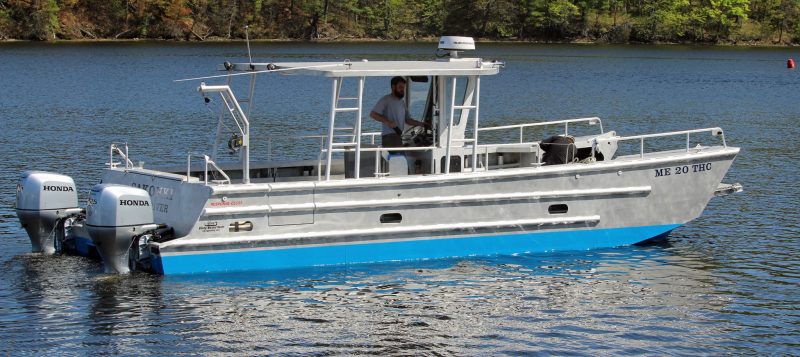A 30-passenger aluminum landing craft built by Viking Welding & Fabrication LLC, Kensington, N.H., will carry students and staff of the University of New England’s marine science program.
The 31’x12’ Sakohki is designed and built for an unusual range of operations, including navigating a tricky river mouth and operating in both shallow and deep waters. One mission is research on intertidal zones, which is why the university sought a landing craft design.
The boat has almost 250 sq. ft. of clear deck space, much of it under an aluminum hard top. Hinged benches provide seating for 28 students around the deck perimeter, with a hinged demonstration table built into the aft side of the helm leaning post.
Sampling and towed gear are deployed with an aft davit and side hull door. A pair of Honda 225-hp outboards propels the Sakohki at a cruising speed of 27 knots at 4,000 rpm, in up to 4’ seas.
All-welded aluminum construction includes 3/4” thick vertical keels and grounding doublers, to handle both planned landings and unplanned groundings.
Addie Waters, assistant director of the University’s Marine Science Center in Biddeford, Maine, describes the design by Response Marine Inc., Newburyport, Mass., as “a student-centered, research capable landing craft that can take an entire class on any and all of our inshore activities.”
The Sakohki is classed as an undocumented research vessel. The success of a similar 35’x13’ design that Viking built for Palm Beach County in 2015 was also a factor in the selection.
Response Marine’s Bill Lincoln describes their “Cat/Tri” concept as a “catamaran with a center hull that, though not dominant, is more significant than seen on traditional catamarans.” Response varies the center hull volume to tweak displacement and trim.
“Naturally, we concentrate initially on the outer hulls and the bridge, but you can only do so much to the catamaran hulls of a planning, high capacity landing craft,” Lincoln said. “So we consider the center hull an important element for the fine-tuning of volume in order to attain desirable trims over the anticipated wide range of displacements.”




